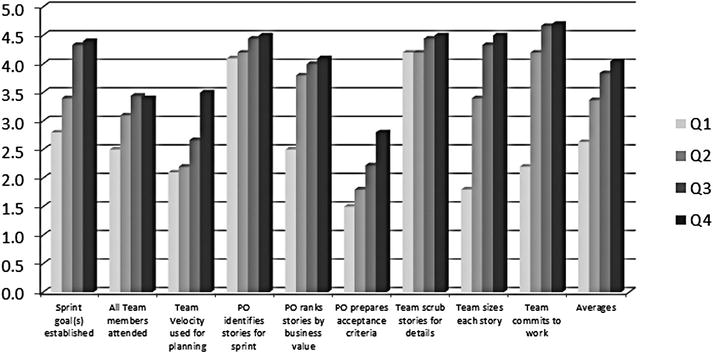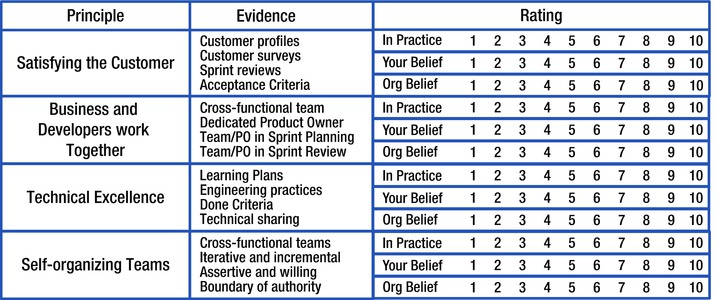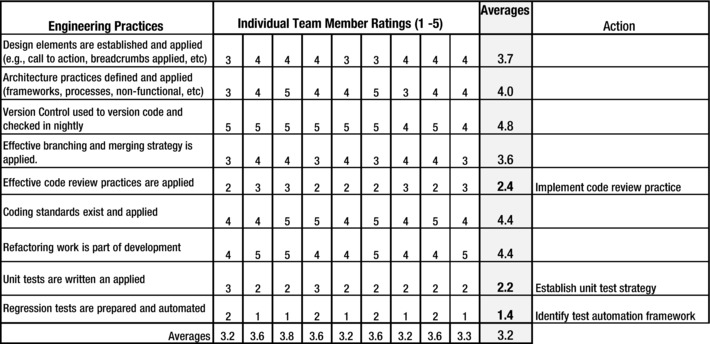Evaluating Agile, Engineering, and Team Capability
Sometimes it is good to know the situation you are getting yourself into.
—Mario Moreira
When starting an Agile deployment effort, it is advantageous to know your starting point. Otherwise, it will be hard to measure how far you have come. This is why I am a fan of baselining the current situation. By this, I mean evaluating the current level of agility, engineering, and team capability. As part of the RICH readiness and deployment model, this allows you to know your starting point, information on where you are strong and where you can improve, and input to prepare an adaptive roadmap for achieving your Agile transformation goal. Important questions that help you gauge your agility are those that help you understand your level of doing Agile and being Agile, with the latter being much more important. Here are two such questions:
- How do you know you have adopted agile processes and practices? This question asks if teams are mechanically “doing Agile” (e.g., applying Scrum). The answer captures whether the mechanical elements of Agile are being applied.
- How do you know you are Agile? This question asks if teams are “being Agile” (if their behavior and culture align with Agile values and principles). The answer captures whether the values and principles of Agile are being applied.
There are two more questions whose answers will help you understand your starting point:
- What is the current state of your engineering practices? This question asks how effectively the team is currently applying engineering practices. If current practices are poor, it can affect your ability to do Agile. The answer helps you know if you have hurdles to overcome.
- What is the current level of Agile experience and interest? This question asks how experienced the team is in applying Agile. The level of experience helps you adapt training and other elements of a deployment.
Now let's delve more deeply into these questions and what such a survey would look like to help you gain answers and establish your baseline.
Agile Practices Adoption
The Agile Practices Adoption survey helps you answer the question, “How do you know you have adopted the agile processes and practices?” This survey tool provides visibility into a team’s adoption level of the agile process and practices that they are applying. These data can be collected via self-survey from team members or through observation by an Agile Coach. The benefit of collecting data around Agile adoption is that you can understand how well your team is “doing Agile.” The results are only for the team to gauge their progress and identify actions for improvement.
To construct a survey, identify the agile practices you want the team to adopt. Then build a set of statements that each team member rates that help you know if the practices are being adopted. Collect the responses and tally for results. Figure 13-1 provides an example of the results from a Sprint Planning adoption survey.

Figure 13-1. Sprint Planning adoption survey to determine what the team thinks their level of adoption is in applying elements of Sprint Planning
In this example, “Team commits to work” is the most highly rated, and “PO prepares acceptance criteria” is the lowest rated. From these results, the team may initiate actions for improvement. A survey like this can be periodically conducted to help the team understand if they are moving in the right direction. From these same data, a trend metric on Sprint Planning adoption over time may be created. See Figure 13-2 for an example.

Figure 13-2. Sprint Planning adoption trend to observe direction of adoption
Notice how “Team Velocity used for planning” was poorly rated in Q1, Q2, and Q3. However, in Q4, the rating increased because after the Q3 survey, the team initiated an improvement action to get educated on the usage of velocity. The periodic results can also be an input into a Sprint Retrospective.
Agile Mindset, Values, and Principles Advisor
The Agile Mindset, Values, and Principles (MVP) Advisor helps you answer the question, “How do you know you are Agile?” A similar question is, “How do I know if I or my team are ‘being Agile’?” The results of this survey provide visibility into the behavioral transformation toward the Agile principles. To create this visibility, each team member self-rates the individual Agile Principles based on what they see in practice, what they personally believe, and what they think the organization believes. For organizational-level visibility, this survey should include input from all of stakeholders and team members to ensure broad coverage.
![]() Agile Pit Stop If you can evaluate yourself on the principles, you can get an idea of whether you are aligned with the Agile Principles and thus the Agile mindset.
Agile Pit Stop If you can evaluate yourself on the principles, you can get an idea of whether you are aligned with the Agile Principles and thus the Agile mindset.
The Agile MVP Advisor survey comes in three parts: principle, evidence of principle in action, and rating area. As you prepare the survey, there should be a discussion of what evidence you would expect to see to bring more objectivity to the process. If you can evaluate your situation highly on the principles, this can give you an idea of whether you are aligned with the Agile Principles and thus whether you have the Agile mindset.
Figure 13-3 is an abbreviated example of the Agile MVP Advisor focusing on just four of the Agile Principles. It is recommended to administer this survey prior to starting a deployment of Agile and then periodically to gauge if you are moving toward the behaviors that align with the Agile principles. The results can help you understand where you align and where you need focus. It can also be an input into a Sprint Retrospective.

Figure 13-3. Abreviated version of the Agile Mindset Values and Principles (Agile MVP) Advisor, a survey to gain an understanding of how Agile you are
Revisit Chapters 6 and 9 to refresh your insight into all of the values and principles to establish a full survey framework to determine whether your team or organization is being Agile.
Having implemented various Agile survey mechanisms in the past, I am a strong proponent of sharing only the aggregate results and sharing them only with those who have taken the survey. No individual results should be shared. If a product team takes the survey, then the aggregate results go only to the team.
If an organization takes the survey, then the whole organization may review the aggregate results. To gain the business benefits of Agile, the whole organization should align with the values and principles. With this in mind, it is beneficial for the whole organization to take this survey. An Agile-minded product team that exists in a hierarchical organization will suffer from this external partnership with the rest of the organization. In other words, if those outside the product team still operate in a hierarchical and big-upfront manner, it can affect the team's ability to align with the Agile values and principles. You may also wish to periodically take this survey to form a trend metric, which will help you understand if the product team or organization is moving toward the direction of transforming their behavior toward Agile values and principles.
Engineering Practices
The engineering practices survey helps you answer the question, “What is the current state of your engineering practices?” Although applying agile practices is important, the level of engineering practices applied is equally important. When you are considering a transition to Agile, you may find that the current engineering practices are problematic. This is why I recommend that prior to implementing Agile, you learn what is working well and what can be improved within the context of engineering practices.
This knowledge has two benefits. The first benefit is that you will better understand the engineering challenges on the team prior to moving to Agile. This baseline determination prevents the Agile deployment from being blamed for an existing engineering problem, and it allows you to more clearly understand these challenges so that they can be addressed as part of the agile transition. The second benefit is that if you find that you have poor practices in engineering areas, you may want to address them before moving to or in parallel with Agile.
To construct a survey, identify engineering practices that you deem important to technical excellence. Then build a set of statements that are self-rated by team members to help you verify if the engineering practices are being followed. Collect the responses and tally for results.
Figure 13-4 provides an example of the results of a state-of-engineering survey. In this example, the team applies version control, architecture, coding standards, and refactoring practices effectively. However, there is significant opportunity for improvement in applying code reviews, unit tests, and regression testing. From these results, the team may initiate actions for improvement.

Figure 13-4. Engineering practices survey to determine what is the current state of your engineering practices
Agile Team Capability
The Agile Team capability survey helps you answer the question, “What is the current level of Agile experience and interest?” Most people are not in a position to hand-select Agile-minded people for their product team. Instead, an existing product team is asked to adopt Agile. This survey can help you understand team members' levels of training, knowledge, experience, and interest.
To construct a survey, identify areas that help you understand the team's experience and interest. Within the context of this survey, you are looking for objective data. Build a set of statements that are answered by team members. Collect the responses and tally for results. Some questions you may ask are:
- Have you had formal training in Agile?
- If so, specify the name and length of the training.
- Do you think you would benefit from Agile training?
- Have you read any books or articles on Agile within the past year?
- If so, specify recently read items.
- Would you be interested in reading Agile books or articles in the future?
- Have you used Agile on any recent projects?
- If so, specify what agile process was used.
- What are the biggest challenges of applying Agile?
- What are the biggest benefits of applying Agile?
Notice that this survey is short and asks for objective details. It helps you understand the level of knowledge and interest a person has. It also provides insights into what they think are benefits and challenges to Agile. This gives you insight into their experience (both good and bad) with Agile. If you are looking to understand a person’s beliefs in the Agile values and principles, then you may use the Agile MVP Advisor described in the second section of this chapter. The Agile Team capability surveys received from team members can be converted into a matrix, as in Figure 13-5 .

Figure 13-5. Team matrix to identify experience, interest, training, challenges, and benefits
The matrix is a summary allowing for a single-view evaluation. This information should only be used at the team level and should not be shared with others. From this matrix, you can see that training is important to at least three of the team members. Notice how Scrum Team members A, B, and C express concern with command-and-control. This is good insight and can help the Agile Coach and/or Agile Deployment Team to be aware and help mitigate this challenge. You may also notice that Scrum Team member D may be problematic. Although this person has been trained, he or she indicates no interest in reading about Agile. This could be someone who wanted the Scrum Master certification but is not really invested in Agile. The information in this matrix can help you understand knowledge levels, risks to be aware of, and if there are any particular areas to focus for training.
Baseline and Improve
The primary purpose of this chapter is to provide you with survey mechanisms that can help you determine your baseline and then improve. The surveys are designed to answer the four questions stated at the beginning of this chapter help you evaluate your overall agility, but, more important, they allow you to know the starting point. You may periodically evaluate how far you have come in the transition.
Baselining provides you visibility into your situation and then information to help you adapt as you move forward. You can consider “baseline and improve” as another form of “inspect and adapt.” Bear in mind that the Agile adoption practices and Agile MVP Advisor survey results can become part of your agile success measures, discussed in the next chapter.

